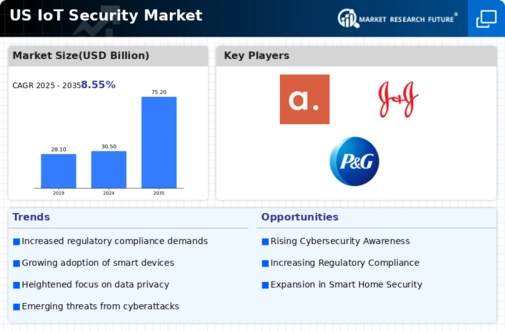Rising Cyber Threats
The increasing frequency and sophistication of cyber threats is a primary driver for the iot security market. As organizations in the US become more reliant on interconnected devices, the potential attack surface expands, making them more vulnerable to breaches. In 2025, it is estimated that cybercrime will cost businesses globally over $10 trillion annually, highlighting the urgency for robust security measures. The iot security market is responding to this challenge by developing advanced solutions that can detect and mitigate threats in real-time. This trend is likely to continue as companies prioritize the protection of sensitive data and critical infrastructure, thereby driving demand for innovative security technologies.
Emergence of Edge Computing
The rise of edge computing is transforming the IoT security market by decentralizing data processing and storage. This shift allows for faster data analysis and response times, which is critical for security applications. In 2025, it is anticipated that over 50% of data generated by IoT devices will be processed at the edge, necessitating robust security measures to protect these decentralized networks. As organizations implement edge computing solutions, they face unique security challenges that require innovative approaches. The IoT security market is likely to evolve in response to these challenges, offering tailored solutions that address the specific vulnerabilities associated with edge computing environments.
Growing Demand for Smart Devices
The proliferation of smart devices in various sectors, including healthcare, manufacturing, and smart homes, is significantly impacting the IoT security market. In 2025, the number of connected devices in the US is projected to exceed 30 billion, creating a pressing need for effective security solutions. As consumers and businesses adopt these technologies, concerns regarding data privacy and security become paramount. Consequently, manufacturers are increasingly investing in security features to ensure compliance with industry standards and to build consumer trust. This growing demand for smart devices is expected to propel the iot security market forward, as organizations seek to safeguard their networks and devices from potential vulnerabilities.
Regulatory Pressures and Compliance
Regulatory pressures are increasingly shaping the landscape of the iot security market. In the US, various regulations mandate stringent security measures for organizations handling sensitive data. Compliance with frameworks such as the NIST Cybersecurity Framework and the California Consumer Privacy Act is becoming essential for businesses. As these regulations evolve, companies are compelled to adopt comprehensive security strategies to avoid penalties and reputational damage. This regulatory environment is likely to drive demand for specialized iot security solutions that ensure compliance while protecting against cyber threats. Consequently, The IoT security market is expected to grow as organizations seek to navigate these complex regulatory requirements.
Increased Investment in Cybersecurity
Investment in cybersecurity is witnessing a substantial rise, which is a crucial driver for the iot security market. In 2025, US companies are projected to allocate over $200 billion towards cybersecurity measures, reflecting a heightened awareness of the risks associated with digital transformation. This influx of capital is likely to foster innovation within the iot security market, as firms seek to develop cutting-edge solutions that address emerging threats. Furthermore, as regulatory bodies impose stricter compliance requirements, organizations are compelled to enhance their security postures, thereby driving further investment in iot security technologies. This trend indicates a robust growth trajectory for the market as businesses prioritize cybersecurity.

















Leave a Comment